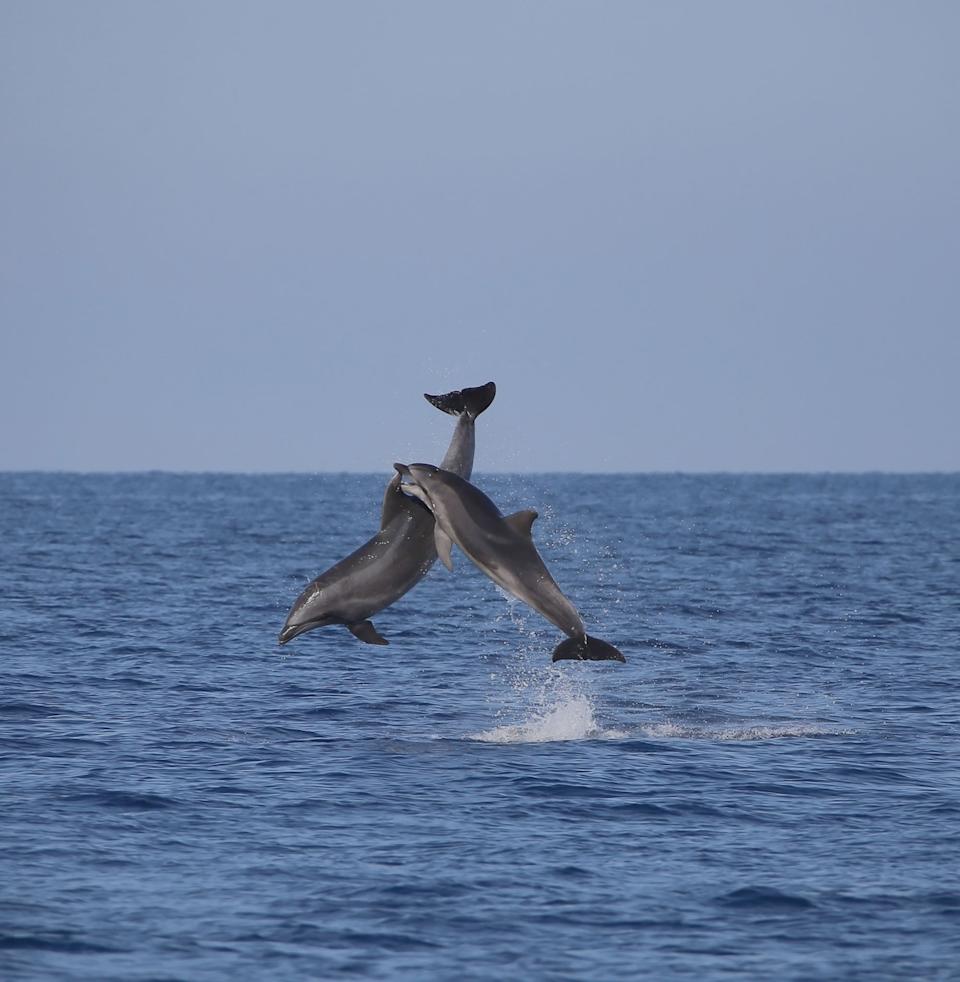
Rome, the Eternal City, is known for its rich history, art, culture, and cuisine. However, a lesser-known fact is that just an hour away from the city, where the Tiber River flows into the Tyrrhenian Sea, lies a unique area inhabited by a population of around 500 bottlenose dolphins. These dolphins, known as the "Capitoline dolphins," have been a part of the coast outside Rome for thousands of years, as evidenced by mosaics from the archaeological site of Ostia Antica that depict them stealing fish from fishermen's nets 2,000 years ago.
Despite their long history in the region, these dolphins have only recently been closely studied, beginning in 2016. A recent study conducted by researchers at the Sapienza University of Rome has revealed a worrying picture of their health and well-being. The analysis of more than 400 photographs taken between 2016 and 2023, depicting 39 individuals of the resident population, showed that 70 percent of the dolphins studied showed signs of malnutrition, such as visible ribs. This is unusual given the richness of food in the area.
The researchers believe that the lack of food might be due to overfishing, which has led to dwindling food resources for the dolphins. Furthermore, half of the dolphins' bodies had marks from the lines and ropes used by fishermen, and amputations were present as well. Nearly all, or 97 percent, of the dolphins had a skin disease caused by pollution from the Tiber River and wastewater from boats passing through. "Pollution can promote immunodepression and cause animals to get sick," says Alice Turchi, a PhD student in environmental and evolutionary biology at the Sapienza University of Rome and author of the study.
In addition to these health issues, researchers also found evidence of fighting among the dolphins. They analyzed teeth marks caused by interactions with other dolphins, which were universal across the population. While these marks are sometimes normal for dolphins as they can bite to communicate dominance during mating competitions or to establish social hierarchies, this population showed an unusually high number. The researchers believe that this may be due to competition for dwindling food resources.
The findings on the Capitoline dolphins' health are consistent with what we observe in many coastal bottlenose dolphin populations worldwide. These populations are exposed to continuous and intense pressure from human activities, ranging from fisheries and maritime traffic to pollution and habitat degradation. For example, in Galicia on the Atlantic coast of Spain, we see similar patterns of skin marks related to both natural and anthropogenic factors. Similarly, studies from other regions such as Sarasota Bay in the United States or various sites in Australia also report high frequencies of marks linked to social interactions.
The Capitoline dolphins' story is a reminder of the need for conservation efforts to protect these vulnerable marine mammals from the impacts of human activities. As we continue to explore and develop our surroundings, it is crucial to remember that we share this planet with many other living beings who depend on it for their survival.
The Capitoline Dolphins represent an intriguing testament to the resilience of nature in facing human-induced changes within its boundaries, highlighting a delicate coexistence between urban development and ecological preservation along Tiber's banks.
The Capitoline Dolphins, resilient emblems of life adapting to unprecedented human impact in the Tiber River despite obstacles threatening their very existence, underscore perfectly how nature's champions persevere amidst environmental challenges."
The compelling narrative in The Capitoline Dolphins exposes the remarkable resilience of these aquatic beings amidst anthropogenic influence on Tiber River, testifying to their extraordinary ability as 'surviving champions' against adversity.
The Capitoline Dolphins, far more than mere relics from the past amidst today'chaotic river Tiber - serve as extraordinary testament to resilience against human impact within our shrinking and polluting waters.
The Capitoline Dolphins, a testament to the remarkable resilience of nature amidst human impact on the Tiber River's waters. Their presence underscores our responsibility as stewards towards protecting ecosystem diversity.
The Capitoline Dolphins, a remarkable testament to resilience against the relentless human impact on Tiber River's ecosystem. Their presence showcases natural adaptations and environmental management we must uphold for future generations.
The Capitoline Dolphins in the Tiber River serve as a testament to nature's resilience, demonstrating how some species can adapt and survive amidst human impact.
The Capitoline Dolphins, a striking testament to resilience and the enduring power of nature amidst human impact on Tiber River's depths.
The Capitoline Dolphins: Surviving Human Impact in the Tiber River embodies a poignant testament to resilience and adaptability within our ever-evolving natural world, where even species that seem least capable of resisting human exertions display remarkable survival strategies.
The Capitoline Dolphins serve as a poignant reminder of how life in the Tiber River对抗人类影响不懈生存的壮举continues, demonstrating resilience and adaptation amidst rapid urbanization.
The Capitoline Dolphins of the Tiber River present a poignant study on how resilient life can be despite human impact, offering an inspiring testament to nature's power over adversity.
The Capitoline Dolphins embody a remarkable feat of resilience, demonstrating how even in the face an adversity from human impact as direct disruption by Tiber River's currents and pollution—life persists. Its story exudes hope for all aquatic ecosystem survivors amidst environmental challenges.
The Capitoline Dolphins represent a remarkable testament to the resilience of nature amidst human-induced impact. Their presence in and around Rome's Tiber River tells an inspiring story not only about adaptation but also survival, serving as symbols againting environmental adversity.
The innovative research and artistic renderings of The Capitoline Dolphins add vibrant dimensions to the enduring resilience demonstrated by natural wonders amid human interventions in Rome's Tiber River, offering a poignant reminder about nature’ advice on coexistence.
The story of the Capitoline Dolphins in Rome's Tiber River highlights nature’s resilience against human impact, a powerful testament to coexistence and conservation amid development.














